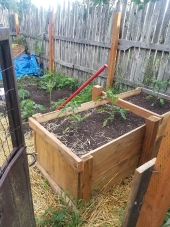you wont get rats in those. if they dig holes underneath youll know where they are and do battle with them. easily managed. Ive never had problems with mine.
One thing you might want to consider is putting smaller diameter wood on top of that so youll get breaking down goodness quicker. If you top that up with soil from there to the top that's a lot of soil and the roots wont get anywhere near the rotting wood. To get maximum benefit you need that rotting wood to be incorporated in the root zone. You only need about 5-8 inches of soil on top as most vegies have pretty shallow roots. Then time it so when the upper wood is rotting down quite well, dig it to incorporate it with the soil. Otherwise, you'll still get many benefits, but the wood will rot away and go downwards with gravity and your plants wont be able to get to it - all the goodies will leach out, eventually.
If you keep putting
compost on, youll be surprised how little the beds will subside as wood rots, I noticed none at all on mine after 5 years, and not a sign of wood remains, but i used much thinner wood than you have used.







